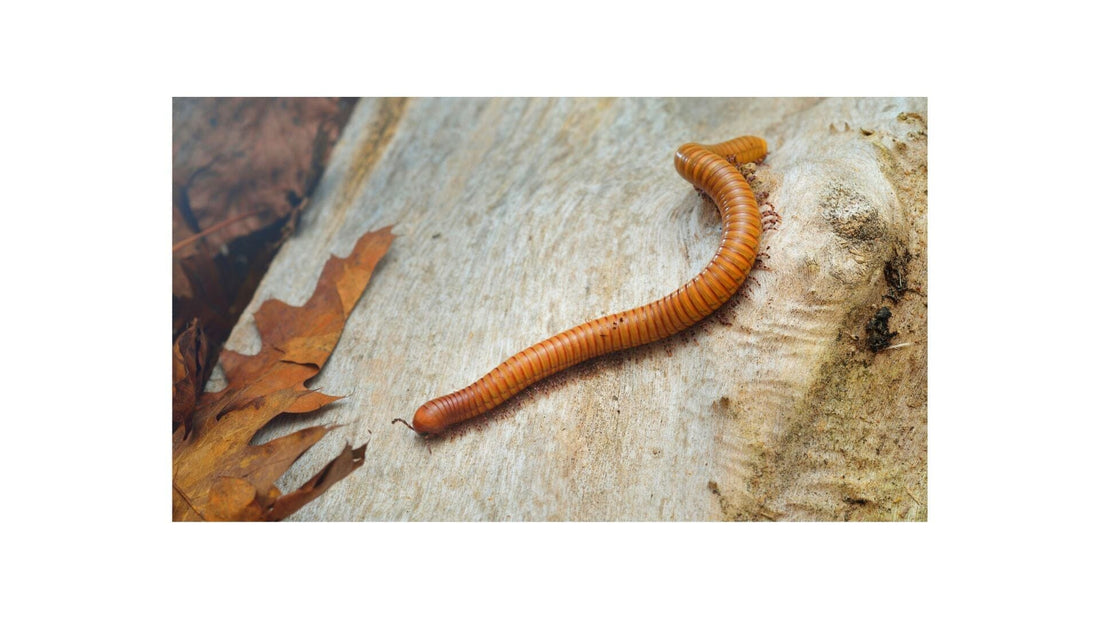Desert millipedes (Orthoporus ornatus) are 3"-9” long terrestrial invertebrates native to southwestern United States and parts of Mexico.
Desert millipedes are a particularly large, robust millipede that range in color from yellow/gold to dark brown, segmented body, with two tiny legs per segment. There is a set of antennae and simple eyes on the head.
Desert millipedes are a common beginner-level millipede because they’re handleable and easy to care for. With good care, they generally have a lifespan of about 10 years.
Minimum terrarium size for desert millipedes
The minimum terrarium size for a desert millipede is generally no smaller than 20”L x 10”W x 12”H, or a 10 gallon tank. However, larger is better as long as the space is used well. The enclosure must have a secure, tightly-fitted lid, or else your pet may escape!
Housing multiple millipedes in the same terrarium usually works well, but if you don’t want baby millipedes, it’s best to keep only one per enclosure. This species does do well in groups, just keep in mind you will want to consider a larger enclosure if you choose to house groups.
Do desert millipedes need UVB?
No, and they seem to avoid light in general. However, if you want to use live plants as part of your terrarium’s setup, you will need a 6500K fluorescent or LED plant light. This can be left on 8-12 hours per day, depending on the time of year.
Best temperature for desert millipedes
Desert millipedes should be kept around 75°F. If this is warmer than your room temperature, use a ceramic heat emitter or a heat pad stuck to the side of the enclosure to accomplish these temperatures. You will need a non proportional thermostat to keep it from getting too hot.
Use a digital probe thermometer to keep track of enclosure temperatures.
Best humidity levels for desert millipedes
As a desert species, desert millipedes do like higher humidity but tend to be a little more forgiving than most millipede species. You do want to try to achieve about 60%-80% humidity, but they need really good ventilation. Simply pour water into about 1/3 of the substrate until it’s moist, but not saturated or swampy. This will give the millipedes options as to which side they want to be in the enclosure based on the dampness of the substrate. You can also mist the enclosure 1-2x/day with a spray bottle of water.
You can keep track of ambient humidity levels with a digital probe hygrometer.
Best substrate for desert millipedes
Desert millipedes should have at least 3” of loose substrate on the floor of their enclosure.
You will also want at least 1” of oak leaf litter (or similar) to provide something for the millipede to root around and hide in.
How to decorate an desert millipede terrarium
Décor isn’t too important to millipedes, but it does add variety and makes the enclosure look nice. It also gives the millipede things to hide under, which is important to their wellbeing. Here are some décor ideas:
- small logs and branches
- cork flats
- live or artificial plants (if you opt for live plants, be sure to double check that the vendor does not use pesticides)
- artificial ornaments
What to feed to an desert millipede
Desert millipedes are primarily detritivorous, which means that they eat decomposing organic matter. Most of their nutrition should come from oak leaf litter, but they also can eat pieces of fresh vegetables and fruits for variety, plus a protein source like fish flakes or dog kibble. Keep a piece of cuttlebone in the enclosure at all times as a calcium supplement.
Here are some fresh food ideas to feed:
- Cucumber
- Melon (leave some rind)
- Carrot
- Apples
Do millipedes need a water bowl?
Yes, it is best to provide a water bowl for your millipede. A small, shallow water dish is ideal. You can also drop pebbles into the dish to help prevent accidental drowning.
How to handle your desert millipede
Although desert millipedes are more handleable than most invertebrates, they don’t appreciate petting and handling in the same way that dogs and cats do. When they are alarmed, they secrete a foul-smelling liquid, which you want to keep away from your eyes, nose, and mouth. Always wash your hands after handling your millipede, and we recommend keeping handling to a minimum.
*This care sheet contains only very basic information. Although it’s a good introduction, please further your research with high-quality sources. The more you know, the better you will be able to care for your pet!











